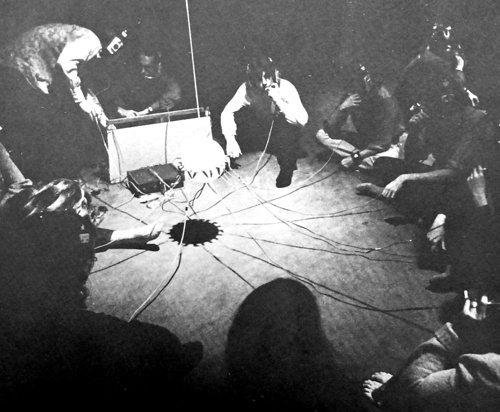listening, auditoria, audiences / écoute, auditeurs, auditoriums : — Studies —
AUDITORIAétude / studyBREATH (GERALD SHAPIRO)
|
|
Cette série explore les œuvres prenant la notion d'auditorium comme principe / This series is a study about works based on principles of auditoria. • COMPOSING THE NOW (Michel Waisvisz) - 2003 — read /lire • JULES VERNE - (Auditoires, Noise et Aventures Acoustiques / ''Audiences, Noise and Acoustic Adventures'') - XIX° — read /lire • BREATH (Gerald Shapiro) - 1971— read /lire • THE HANDPHONE TABLE (Laurie Anderson) - 1978— read /lire |

|
cliquez sur les images pour les agrandir
Menu AUDIAshapiro :
Presentation(Edit)
BREATH
Gerald Shapiro
1971.
| Durée approximative | — ? | |
| Dates de composition | — 1971 | |
| Création | — performed with From the Yellow Castle and The Second Piece as a one-man concert at Automation House, New York City, 1971, sponsored by the Intermedia Institute - Intermedia Institute (programme 1971) (pdf) | |
| Dispositif : | — protocole de participation d'auditeurs avec traitements électroniques —— for interactive audience participation with electronics | |
| Éditeur : | — |
Cette œuvre fait partie d'une série d'œuvres réalisée par Gerald Shapiro entre 1968 et 1975 et faisant participer les auditeurs.
- From the Yellow Castle for interactive audience participation with electronics
(in collaboration with Jim Minor and Bob Carrignan)
— Brown University, 1968
— Massachusetts College of Art, 1968
— University of Illinois Festival of Contemporary Music, 1969
— George Washington University, 1970
— Peabody College, Nashville, TN, 1970
— Central Pennsylvania Festival of the Arts, 1970 - Breath and The Second Piece for interactive audience participation with electronics
— These two pieces performed with From the Yellow Castle as a one-man concert at Automation House, New York City, 1971, sponsored by the Intermedia Institute. - Winter Birch for interactive audience participation with electronics
— University of Pittsburgh, 1972
— Brown University, 1972
— University of California at San Diego, 1972
— Colorado College, 1972
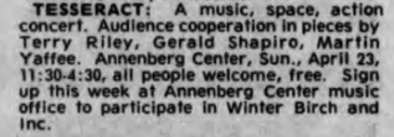 Annonce in The Daily Pennsylvania, Vol. LXXXVIII, N°40, Wednesday April 12, 1972, page 4 (Campus Events) |
- Sitting Quietly, Thinking About Last Fall for interactive audience participation with electronics
— University of Illinois, 1973
— York University, Toronto, 1973
— Brown University, 1975
| Gerald M. Shapiro (born 1942 in Philadelphia) is an American composer of acoustic and electronic music. Shapiro studied first at the Eastman School of Music, where he received a Bachelor of Music degree with distinction in 1964. He then did graduate work at Mills College, where he received an M.A. in 1967, the University of California, Davis, the San Francisco Tape Music Center, and in Paris at the Conservatoire National de Musique and the École Normale Supérieure de Musique. His principal composition teachers were Darius Milhaud, Morton Subotnick, Karlheinz Stockhausen, Olivier Messiaen, and Nadia Boulanger. Since 1967 he has taught at Brown University, where he is currently Professor of Music. He's founder of the MacColl Studio for Electronic Music at Brown University and designer of the well-known ARP synthesizer (an electronic musical instrument). His compositions have been performed throughout the United States and Europe, and are recorded on the Naxos and Neuma labels. Gerald Shapiro cv (pdf) | Gerald M. Shapiro né en 1942 à Philadelphie est un compositeur américain de musique instrumentale et électronique. Il est diplômé de la Eastman School of Music en 1964. Il continua ses études au Mills College jusqu'en 1967, puis à la University of California, Davis, au San Francisco Tape Music Center, et au Conservatoire National de Musique de Paris et l'École Normale Supérieure de Musique, auprès de Darius Milhaud, Morton Subotnick, Karlheinz Stockhausen, Olivier Messiaen, et Nadia Boulanger. Depuis 1967 il enseigne à la Brown University où il est actuellement professeur émérite. Il a fondé le MacColl Studio for Electronic Music à la Brown University et il a développé le bien connu synthétiseur ARP. Ses œuvres sont jouées dans le monde entier entre les États-Unis et l'Europe, et ont été enregistrées sur les labels discographiques Naxos et Neuma. cv Gerald Shapiro (pdf) http://geraldshapiro.com/ https://vivo.brown.edu/display/gmshapir http://www.bussigel.com/shep2/music.html |
SCORE(Edit)
(In Source: music of the avant garde, nr. 10)
CONCERT(Edit)
(Automation House, New York City, 1971)
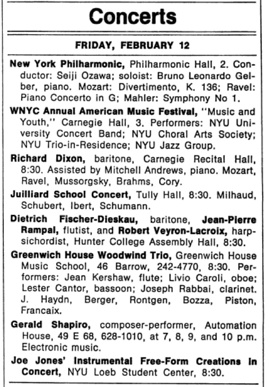 Annonce du concert, in New York Magazine, 15 fév. 1971, Vol. 4, N°7 |
Article in Brown Alumni Monthly March 1971, Vol. 71, No. 6, , pp. 7-8 (Brown University, Providence) |  A piece of music you really feel "Close your eyes and leave them closed." Those instructions begin the score of "The Second Piece — The One about Finding Your Way in the Dark" by electronic music composer and assistant professor of music Gerald Shapiro. The piece was first introduced on Feb. 12 during Shapiro's New York debut at the Intermedia Institute at Automation House. There are two ways to describe "The Second Piece" — how it works and how it feels. To begin with how it feels: one is equipped with a headset with a light on top, a wired sock, and a small box that looks something like a camera case. Thus equipped, the participant enters a darkened room with his eyes closed. As he walks around, the sound coming through his earphones constantly changes, becoming louder as he nears another person and diminishing as the distance increases. It becomes possible to "see" where other people are. When two participants touch one another, the loud steady sound that has indicated each other's presence shuts off and another sound replaces it. The quality of this sound is different for each pair of participants and it can be altered by using different forms of touching. Lightly tapping another person, for example, produces a different sound than pressing firmly. Finding a vocabulary to describe the effect of participating in "The Second Piece" is very difficult. "It's like a trip to another planet," said one girl. "It's a different world." The outer space analogy is reinforced by the science fiction look of the electronic apparatus and by the strangeness of communicating entirely by touch and motion made audible. After wandering around the darkened room for a while, one begins to recognize other people in the space solely by the sound which results when one touches them. Gradually participants learn to communicate with one another in more sophisticated ways by varying contacts which result in varying sounds. It's a little bit like learning a strange language. It's also possible to produce something resembling a tune by alternately touching several different people in sequence. To explain the philosophy behind "The Second Piece," Gerald Shapiro wrote in the program notes: "1 have come to conceive of music as a way of listening — rather than the sound which is listened to, and of a piece of music as a process of interaction resulting in that special kind of listening we call music. 'The Second Piece' is participant-activated, there are neither performers nor audience. Neither is there any performance in the usual sense of the word, for what is composed is the listening process itself… The participants are involved in an intensely communicative relationship with one another and with the technology of the piece. The medium and the end result of that relationship is sound and the experience for those who have participated in the piece is one of total involvement in that sound… » Shapiro composed "The Second Piece" in collaboration with Bill Patterson, a research engineer at Brown, whose day-to-day work involves designing cameras used to photograph Mars. Patterson designed the electronic apparatus for the piece and he might be the only one who fully understands how it all works. To quote from the program notes: "Each participant is equipped with a helmet and each helmet contains circuitry which transmits a unique, complex, low-frequency audio signal by modulating an invisible, infra-red light beam. Other circuitry detects those signals and routes them to the headset. Because of the highly directional, short-range characteristics of this type of transmission, each participant will be able to… understand the placement and distance of the other participants. The auditory results of this scanning procedure will be a continuous but constantly shifting soundfield as the participants face in different directions and as other participants move in and out of range. "The helmets also contain a high frequency oscillator whose output makes a direct electrical connection to the skin of the participant and to one input of a beat frequency detector. When two participants touch, all transmission and detection of light beam carried signal is turned off for the participants involved and they hear instead a sound whose frequency represents the difference between their individual high frequency oscillators." So much for technical explanations. The instruments for the piece were built by friends and students in Shapiro's electronic music studio. For weeks before the show, the basement studio was a Santa's workshop of continuous activity, with helpers wiring and soldering circuits, sewing cases for the instruments, testing completed work, and searching for lost parts. If participating in "The Second Piece" was like a trip to another planet, the effort that made it all possible seemed as complex and sustained as preparations for a moon shot. [Download article (pdf)] |
PROGRAMME NOTES(Edit)
(Automation House, New York City, 1971) — [Download programme notes from Intermedia Institute (pdf)]
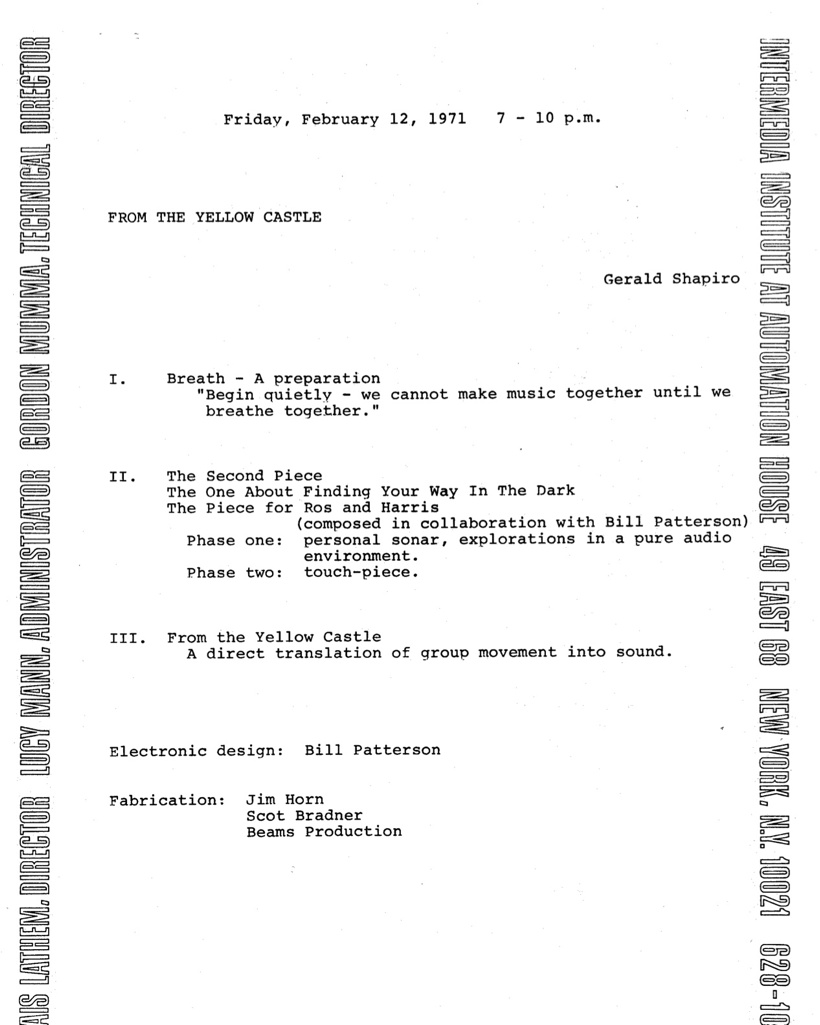  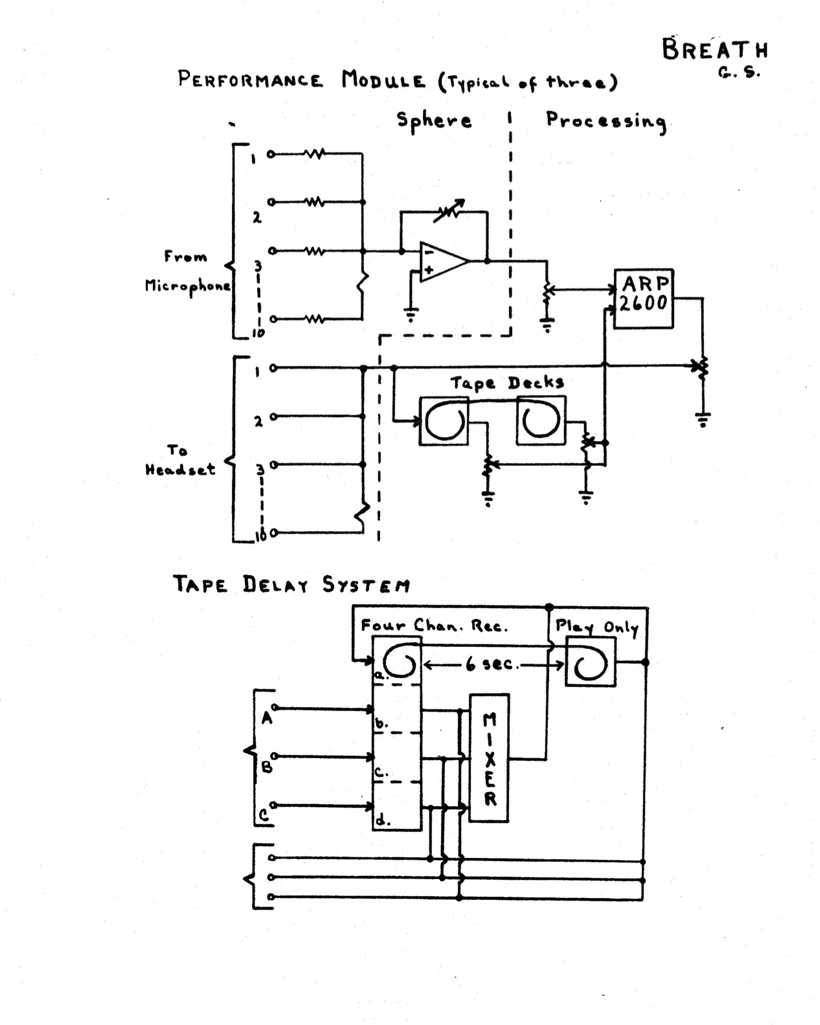 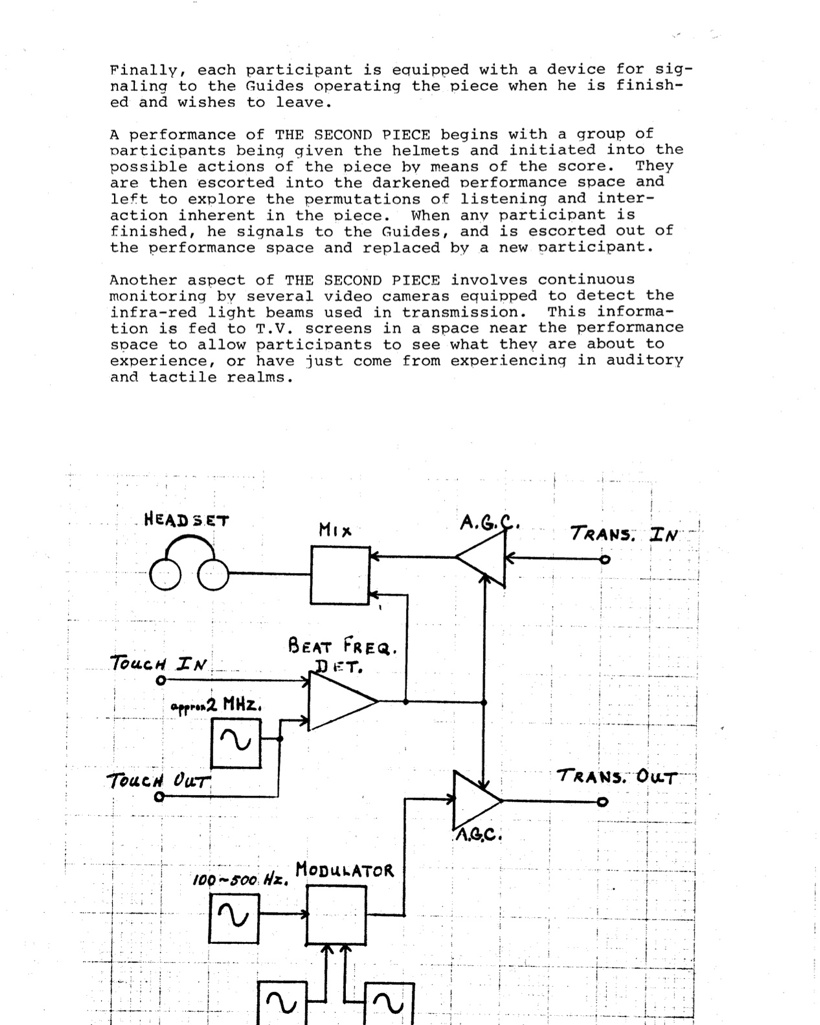  |

